Serviços Personalizados
Artigo
Links relacionados
Compartilhar
RSBO (Online)
versão On-line ISSN 1984-5685
RSBO (Online) vol.12 no.3 Joinville Jul./Set. 2015
ORIGINAL RESEARCH ARTICLE
Epidemiological study to determine factors associated with dental caries in schoolers
Camila CastroI; Carolina Dea BruzamolinI; João Gilberto DudaI; João Armando BrancherI; Eduardo PizzattoI
I Department of Dentistry, Positivo University – Curitiba – PR – Brazil
ABSTRACT
Introduction:Dental caries is a large problem affecting all population. In Brazil, caries prevalence has decreased over the last years, but it is still a public health issue requiring frequent evaluation and care by dentists. Objective: To evaluate the oral health conditions of schoolers aged 5-12 years relating them with socioeconomic and demographic determinants. Material and methods: The children were examined by a previously calibrated examiner to obtain DMF and dmf scores. The parents answered a questionnaire regarding to the socioeconomic condition. Prior to the examinations, the parents signed a free and clarified consent form and only their children were evaluated. The results were analyzed descriptively and by Chi-square test, at significance level of p<0.05. Results: : The sample (n=111) showed a mean age of 7+1.7 years (mean + standard deviation), composed of 58 boys and 58 girls. 66.6% of the sample exhibited dmf values = 0, while 102 schoolers had DMF values = 0. With regard to the parents' education level, 78.37% of the mothers had more than 9 years of education and 43.34% of the fathers had 9 to 11 years of study. Concerning to family income, 36.93% of the families presented mean income of 1-3 minimum wages (R$ 788.00 to R$ 2,364.00). No statistically significant differences (p≤0.05) were seen between caries rates vs. parents' education and caries rates vs. family income. Conclusion: 5-12 year schoolers showed low dmf and DMF values, suggesting that parents' education and income might have influenced on the results. Further studies are necessary to understand/assess the predisposing factors to dental caries development.
Keywords: dental caries; socioeconomic factors; oral health.
Introduction
Dental caries is a multifactorial disease affecting most of the worldwide population. Interconnected factors influenced on the risk for developing the disease, among them environmental factors (oral bacteria), behavioral factors (diet and oral hygiene), endogenous resources (tooth position and morphology; enamel composition; salivary composition and flow), and demographic characteristics (age, sex, race, socioeconomic status and access to oral health care) 1,8.
Moysés 16 observed that the worst socioeconomic conditions are directly related to a higher consumption of sugar, worst oral health condition, difficulty of access to toothbrushes and dentifrices, difficulty of access to dental care, leading the population more exposed to these risk factors consequently increasing dental caries prevalence.
Baldani et al. 3conducted an epidemiologic survey associating dental caries to socioeconomic factors in many cities of Parana, Brazil through DMF value and social aspects showed in databases (IBGE and DataSUS) and found that the cities with the lower incomes and education had the higher caries prevalence.
The study of Martins et al. 14 aimed to investigate through multivariate analysis the association of caries with variables as: parents' education, number of people living in same house, school type and family income. The data were collected through DMF scores and questionnaire. The authors found a direct relationship between caries development in children having the lowest family income, studying in public schools and whose parents had the smallest education level.
The epidemiologic surveys are necessary both for knowing the prevalence of oral diseases and evaluating the oral treatment needs 19. These studies are associated with the application of structured questionnaires with demographic, socioeconomic, behavioral and access to health service variables. Such methodology enables to evaluate the possible association of these variables with caries disease.
One way of diagnosing and measuring the problems in oral health area is to use the health indicators. In Dentistry, an index frequently employed in epidemiologic surveys to assess the number of teeth affected by caries is DMF (dmf), proposed by Klein and Palmer, in 1937. Over the last decades, other indexes have been created and modified to meet the research's objectives. However, DMF index is a valuable, reliable, sensible, and acceptable index to be used to assess oral health regarding to caries in a population 22.
It is of utmost importance for any planning and action in health promotion to collect epidemiologic data to evaluate the situation of the health conditions of a given population. Notwithstanding, some Brazilian cities, as the city of Pinhais, does not have epidemiologic data on oral health of 5-12 year schoolers, the age range considered by WHO 4.
Given that importance and aiming to understand the oral health situation this study aimed to investigate the association between caries severity and its determinants in 5-12 year schoolers in the city of Curitiba, Parana, Brazil.
Material and methods
This present study was conducted according to Declaration of Helsinki and after the approval of the Institutional Review Board regarding ethical aspects (protocol no. #879404).
The sample comprised 111 schoolers of the Municipal School Campo Mourão (city of Curitiba, Parana, Brazil) aged between 5 and 12 years, regularly enrolled and living in the city of Curitiba whose parents read and signed a free and clarified consent form. Exclusion criteria comprised the presence of fixed orthodontic appliances and lack of signature on the free and clarified consent form.
DMF and dmf indexes were used to evaluate dental caries, according to the guidelines of the World Health Organization 19. Both the examiner and the note taker were trained and calibrated. All examinations were performed with the aid of disposable wooden spatula, and both the child and the examiner were seated, under natural light, strictly following the biosecurity guidelines. Both the examiner and note taker wore apron, hat, mask and disposable gloves during the examinations.
Aiming at the socioeconomic analysis, a questionnaire was sent to all parents comprising the following variables: years of education of the father and mother; number of rooms in the house; house type; number of people living in the house; number of gadgets in the house (TV, DVD, computer, car, and washing machine); and parents' perception towards the oral health of the child. This questionnaire was based on the interview guide of SB Brazil Project, with some modifications to meet the aims of this present study and the age range of interest.
The data were tabulated and submitted to descriptive statistics analysis to obtain the final results.
Results
With regard to sample characterization, the schoolers (n=111) had mean age of 7+1.7 yeas (mean + standard deviation), with 58 males and 53 females (n=111).
Considering dmf values (primary teeth), most of the sample showed values equal or close to 0 (66.6%), with mean ± standard deviation of 0.86±1.61 (Figure 1). For permanent dentition, DMF values evidenced very low caries rate because DMF mean ± standard deviation was 0.13±0.469 (Figure 2).
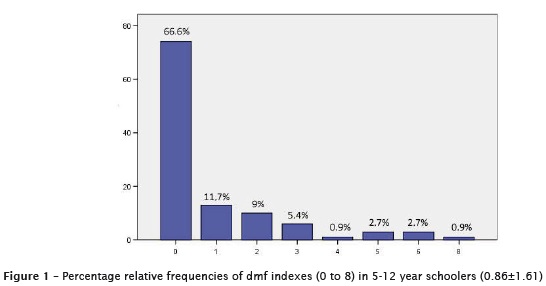
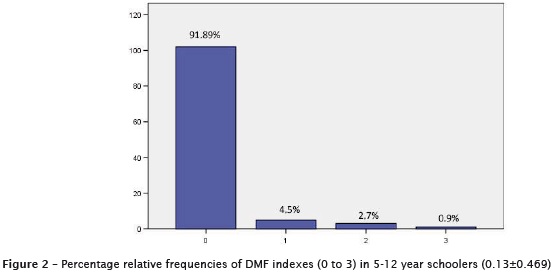
With respect to the parents' education, the mothers exhibited a mean of 3.89 ± 1.33 years of study. 6.3% did not answered, 0.9% did not attend school, and 5.4% had from 1 to 4 years of study (basic education), 9% had from 5 to 8 years of study (elementary school), 41.44% from 9 to 11 years of study (high school) and 36.93% more than 12 years of study (college) (Figure 3). On the other hand, 43.34% of the fathers had from 9 to 11 years of study with mean + standard deviation of 3.74 ± 1.27 (Figure 4).
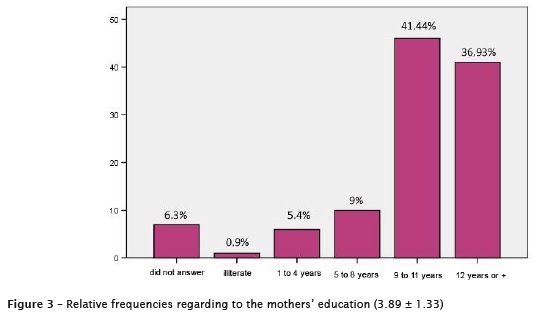

It was possible to verify the family income and 36.93% of the families had an income from 1 to 3 minimum wages (R$ 788.00 to R$ 2,364.00), 27.92% had from 3 to 5 minimum wages (R$ 2,364.00 to R$ 3,940.00) (2.42 ± 1.24). 13.5% of the respondents did not report the family income (Figure 5).
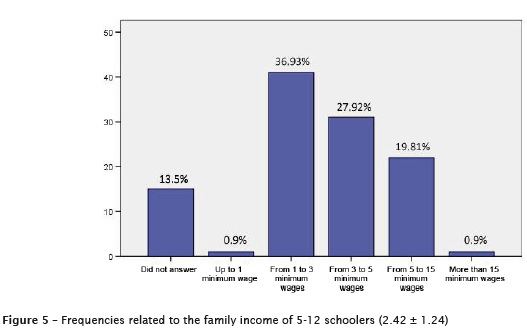
The association between the dmf and DMF indexes, parents' education, and family income did not show statistically significant differences (p≤0.05) (Table I).
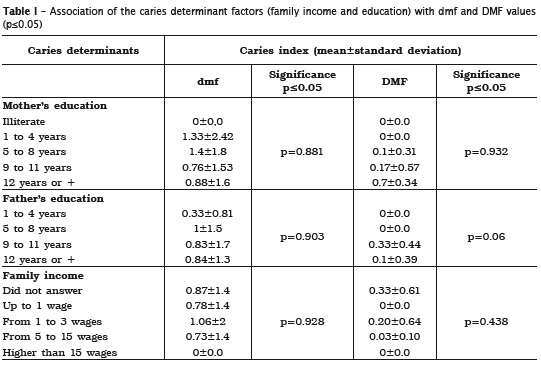
Discussion
The result of this study exhibited a mean dmf/DMF of 0.86 and 0.13, respectively, for 5-12 year-old children. These are favorable data when compared to those of the Brazilian health survey, whose means were 2.46 for 5 years and 1.53 for 12 years 6. By analyzing this aforementioned result, one can infer that dental caries has been controlled and prevented in the studied population, providing a better quality of life to the children.
The epidemiologic studies have been frequently conducted and enable the monitoring of the caries experience in children and adults in Brazil. Most of these studies cover the prevalence and severity of caries in preschoolers and schoolers, by assessing the prevalence of decayed teeth, oral hygiene, and factors associated with the parents and/or guardians 23.
Many researches indicate that the relation of demographic, socioeconomic and behavioral factors is also of utmost importance for dental caries development. The factors most having the highest positive association with dental caries development were: low parents' education, family income, social class 1,5,9,10,17,23-26, and school type 7,14.
The evaluated children studied at a public school in the city of Curitiba. Notwithstanding, they showed low index of decayed tooth with 91.89% of the sample without decayed primary tooth and 74.77% of the sample without decayed permanent tooth. These results are different from those observed by Barbosa et al. 4, who evaluated the dental caries prevalence in 5 year-old children studying in public schools in the city of Curitiba and found a high dental caries index (52.9%).
Some authors considered that socioeconomic situation is a determinant factor for risk to caries disease and this can be characterized as a disease of developing countries, such as Brazil 12,16. It is worth affirming that in this present study, the families mostly exhibited (48.63%) an income equal to or higher than R$ 2,364.00, classified as middle class. One can infer that the social level interfere on dmf and DMF values, because the schoolers had low caries index, although without statistically significance (p≤0.05).
In the studies of Mendes et al. 15 and Nicolau et al. 18, youths of families with incomes of up to 2.4 minimum wages (R$ 1,891.2) had more prevalence of decayed teeth than those having family income higher than 2.4 minimum wages. Thus, low family income is associated with dental caries experience.
The studies of Oliveira et al. 20, Perera and Ekanayake 22, Aida et al. 1 and Van Nieuwenhuysen et al. 28 demonstrated that the family income and the parents' education were or were not related with caries presence. A study showed that the mothers with more than five years of education put their children at a higher risk of developing caries lesions than those mothers with higher education. The literature has reported that the parents' low education will influence the adoption of healthy oral hygiene habits of the children, so that periodical actions of oral health education and promotion are necessary towards to the parents and guardians are necessary 27.
In this present study, no statistically significance differences (p<0.05) were found in the association of parents' education with the caries index exhibited by the studied population, because both the mothers (78.37%) and the fathers (70.26%) had high education. Notwithstanding, the high education of the parents/guardians can be used as a possible explanation for the low dmf (66.6%) and DMF (91.89%) value equal to 0. Within this context, we can assume that the parents' education influence on the presence of the caries lesions of their children.
Identifying the collective factors predisposing to dental caries in preschoolers is a fundamental tool to enable suitable oral health care and redirection of the actions that should be targeted to health attention. It is of outmost importance during daily dental practice that both the individual and the collective oral health are treated through the universal access to the dental services and assuring the equity and resolutivity in treating the general and individual dental needs of a given population.
Conclusion
Based in the results, it can be concluded that:
• 5-12 year-old schoolers had low dmf/DMF values, indicating a healthy oral health and adequate oral hygiene care;
• The parents' education and the family income seems to influence on the caries index of the studied population;
• By relating the socioeconomic factors (family income) with parents' education, no statistically significant differences (p≤0.05) in the dmf/DMF values were found;
• Further similar studies are necessary to evaluate better the caries determinants in schoolers from public schools aiming at meeting the demands according to their needs.
References
1. Aida J, Ando Y, Oosaka M, Niimi K, Morita M. Contribuitions of social context to inequality in dental caries: a multilevel analysis of Japanese 3-year-old children. Community Dent Oral Epidemiol. 2008;36:149-56. [ Links ]
2. Ajayi DM, Abiodun-Solanke IF. Sociobehavioural risk factors of dental caries among selected adolescents in Ibadan, Nigeria. Pediatric Dental Journal. 2014;24(1):1-6.
3. Baldani MH, Vasconcelos AGG, Antunes JLF. Associação do índice CPO-D com indicadores sócio-econômicos e de provisão de serviços odontológicos no estado do Paraná, Brasil. Cad Saúde Pública. 2004;20(1):143-52.
4. Barbosa APM, Kriger L, Moyses ST, Moyses SJ. Prevalência da doença cárie em crianças de cinco anos de idade na cidade de Curitiba – análise crítica. Epidemiol Serv Saúde. 2007;16(2): 142-5.
5. Bucker WCV, Pessôa CP, Alves TDB, Oliveira MC. Associação entre severidade de cárie dentária e aspectos sociocomportamentais em escolares de 12 anos no município de Feira de Santana, Bahia. Revista Baiana de Saúde Pública. 2001;35(1): 103-11.
6. Brasil. Ministério da Saúde. Projeto SB Brasil 2010: pesquisa nacional de saúde bucal. Resultados principais. Brasília; 2012.
7. Cypriano S, Hugo FN, Sciamarelli MC, Tôrres LHN, Souza MLR, Wada RS. Fatores associados à experiência de cárie em escolares de um município com baixa prevalência de cárie dentária. Ciência & Saúde Coletiva. 2011;16(10):4095-106.
8. Declerck D, Leroy R, Martens L, Lesaffre E, Garcia-Zattera MJ, Broucke VS et al. Factors associated with prevalence and severity of caries experience in preschool children. Community Dental Oral Epidemiol. 2008;36:168-78.
9. Dini EL, Holt RD, Bedi R. Caries and its association with infant feeding and oral healthrelated behaviours in 3-4-year-old Brazilian children. Community Dent Oral Epidemiol. 2000;28:241-8.
10. Freire MCM, Reis SCGB, Figueiredo N, Peres KG, Moreira RF, Antunes JLF. Individual and contextual determinants of dental caries in Brazilian 12-year-olds in 2010. Rev Saúde Pública. 2013;47(Supl 3):1-10.
11. Guerra LM, Pereira AC, Pereira SM, Meneghim MC. Avaliação de variáveis socioeconômicas na prevalência de cárie e fluorose em municípios com e sem fluoretação das águas de abastecimento. Rev Odontol Unesp. 2010 Sep/Oct;39(5):255-62.
12. Gushi LL, Soares MDAC, Forni TI, Vieira V, Wada RS, Sousa MDAL. Cárie dentária entre os adolescentes e sua relação com as variáveis sócioeconômicas. J Appl Oral Sci. 2005;13(3):305-11.
13. Instituto Brasileiro de Geografia e Estatística – IBGE. Perfil dos municípios brasileiros 2009 [cited 2015 May 5]. Available from: URL:http:// www.ibge.gov.br/.
14. Martins MT, Sardenberg F, Abreu MH, Vale MP, Paiva SM, Pordeus IA. Factors associated with dental caries in Brazilian children: a multilevel approach. Community Dent Oral Epidemiol. 2014;42(4):289-99.
15. Mendes LGA, Biazenic MGH, Crosato ME, Mendes MOA. Dental caries and associated factors among Brazilian adolescents: a longitudinal study. Braz J Oral Sci. 2008;7:1614-9.
16. Moysés SJ. Desigualdades em saúde bucal e desenvolvimento humano: um ensaio em preto, branco e alguns tons de cinza. Rev Bras Odonto Saúde Col. 2000;1(1):7-17.
17. Narang R, Saha S, Mittal L, Anamika, Gupta YK. Socioeconomic status of the family and caries experience among 2e6 years old preschool children of Lucknow city, India. International Journal of Dental Science and Research. 2013:12-5.
18. Nicolau B, Marcenes W, Bartley M, Sheiham A. A life course approach to assessing causes of dental caries experience: the relationship between biological, behavioural, socioeconomic and psychological conditions and caries in adolescents. Caries Res. 2003;37:319-26.
19. Oliveira AGRC, Unfer B, Costa ICC, Arcieri RM, Guimarães LOCG, Saliba NA. Levantamentos epidemiológicos em saúde bucal: análise da metodologia proposta pela Organização Mundial da Saúde. Rev Bras Epidemiol. 1998;1(2).
20. Oliveira LB, Sheihman A, Bonecker M. Exploring the association of dental caries with factors and a nutritional status in Brazilian preschool children. Eur J Oral Sci. 2008;116:37-43.
21. Organização Mundial de Saúde. Levantamento epidemiológico básico em saúde bucal: manual de instruções. 4. ed. Genebra: OMS; 1997.
22. Perera I, Ekanayake L. Social gradient in dental caries among adolescents in Sri Lanka. Caries Res. 2008;42:105-11.
23. Peres KGA, Bastos JRM, Latorre MRDO. Severidade de cárie em crianças e relação com aspectos sociais e comportamentais. Rev Saúde Pública. 2000;34(4):402-8.
24. Peres MA, Latorre MRDO, Sheihman A, Peres KG, Barros FC, Hernandez PG et al. Determinantes sociais e biológicos da cárie dentária em crianças de 6 anos de idade: um estudo transversal aninhado numa coorte de nascidos vivos no Sul do Brasil. Rev Bras Epidemiol. 2003;6(4).
25. Pizzo G, Piscopo MR, Matranga D, Luparello M, Pizzo I, Giuliana G. Prevalence and sociobehavioral determinants of dental caries in Sicilian schoolchildren. Med Sci Monit. 2010;16(10): 83-9.
26. Shaffer JR, Polk DE, Feingold E, Wang X, Cuenco KT, Weeks DE et al. Demographic, socioeconomic, and behavioral factors affecting pat terns of tooth decay in the permanent dentition: principal components and factor analyses. Community Dent Oral Epidemiol. 2013;41:364-73.
27. Silva PF, Freitas CHSM. Análise de motivos que dificultam a adoção de hábitos de higiene bucal saudáveis com relação à cárie dentária: avaliação de uma escola pública da Paraíba. 2011;47(1):38-44.
28. Van Nieuwenhuysen JP, Carvalho JC, D'Hoore W. Caries reduction in Belgian 12-year-old children related to socioeconomic status. Acta Odontol Scand. 2002;60:123-8.
 Corresponding author:
Corresponding author:
Eduardo Pizzatto
Departamento de Odontologia, Universidade Positivo
Rua Professor Pedro Viriato Parigot de Souza, 5.300 – Campo Comprido
CEP 81280-330 – Curitiba – PR – Brasil
Received for publication: April 13, 2015
Accepted for publication: July 12, 2015













